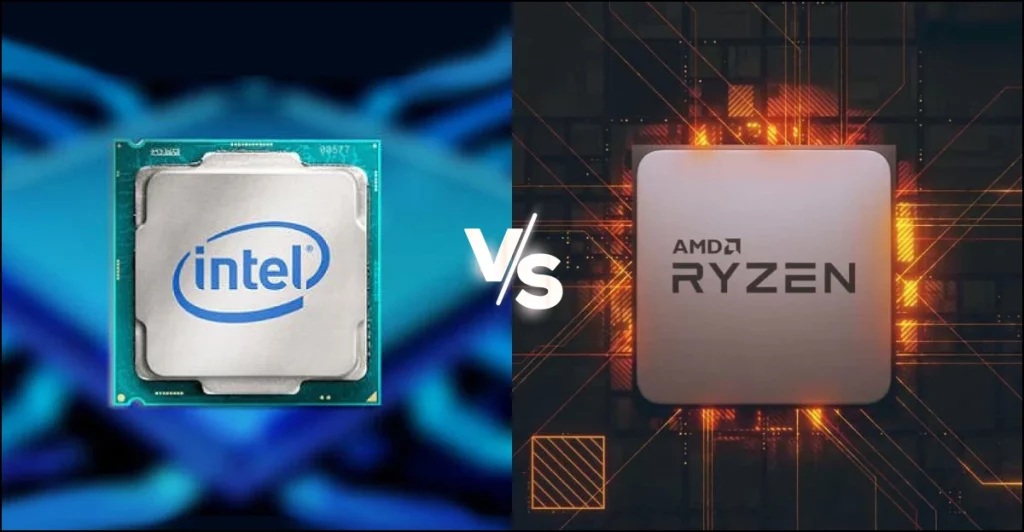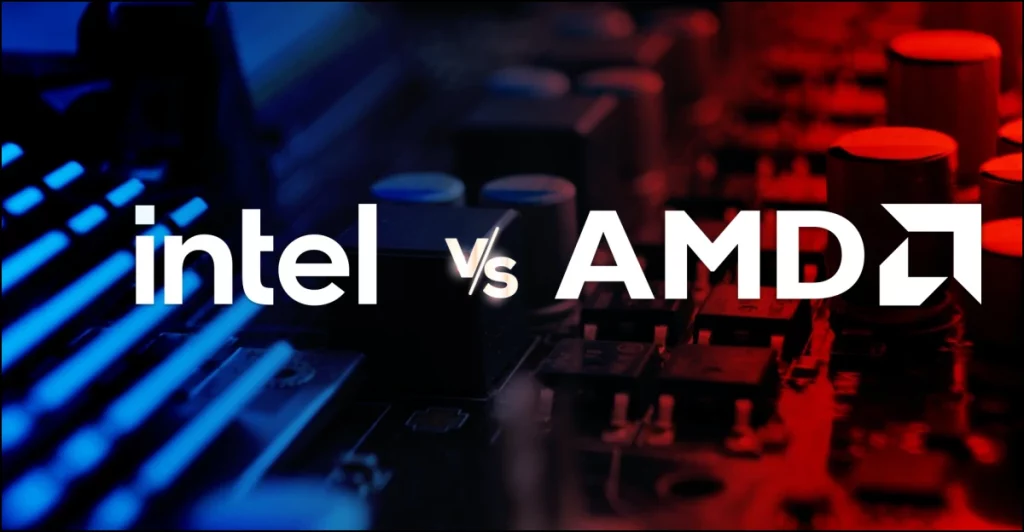The chips market is being flooded with various names and among those, the two names that are not only at the front but also are great competitors of each other are Intel vs AMD.

Company Overview
Both Intel and AMD have a great history and market share. The following table provides an overview of both the companies-.
| Company name | Intel | AMD (Advanced Micro Devices) |
| Founded | July 18, 1968 | May 1, 1969 |
| Founder | Gordon Moore and Robert Noyce | Jerry Sanders, Jack Gifford, Edwin Turney, Frank Botte, Larry Stenger, Sven Simonsen, John Carey, Jim Giles |
| Head office | Santa Clara, California, United States | Santa Clara, California, United States |
| CEO | Patrick P. Gelsinger | Lisa Su |
| Market share (2023) | 9.1% (global semiconductor chip market) 78% (CPU market) | 20.4% (semiconductor chips market) 13% (CPU market) |
| Revenue (Q1 2024) | $12.7 billion | $5.47 billion |
| Sales of chips per year | Nearly 2 billion units per year. | N/A |
Intel clearly has recorded a higher number for its revenue as compared to AMD’s revenue and sells around 2 billion units of chips every year to around 2000 customers globally, while the numbers for AMD weren’t available.
Intel vs AMD: Comparison
Both the companies originating from the same place and operating in the same industry differ from each other on several aspects. Here we’ll some of the factors.
| Factors | Intel | AMD |
| Performance | These are known for their strong single core performance, enhancing them to excel in various tasks that mainly rely heavily on single core strength. | These often boast a higher core count, resulting in multitasking capabilities. |
| Architecture used | Intel uses x86 architecture, which is a complex instruction set computer architecture. | They also use x8 architecture along with their own developed processor architecture named, “x86-64” or “AMD64”. |
| Price | Intel chips are slightly pricier than the rest. | These are generally considered as quite affordable ones, making it a go to choice for the budget conscious consumers. |
| Value | It addresses those consumers who seek cutting edge technology with top performance. | AMD chips are said to offer better value for money. |
| Compatibility | These are more frequent in the market and have broader software compatibility and optimization. | This too offers software of higher compatibility with various applications. |
| Product offerings | Chipsets, Network interface controllers, Flash memory, Graphic processing units (GPUs),Field programmable gate arrays (FPGAs),Other devices. | Its main products includes;Microprocessors, Embedded processors,Motherboard chipsets,Workstations, Embedded system applications, Graphics processor, etc. |
One of the main difference between the two is that, Intel itself manufacturers chips with its own technology, while AMD rely on third party, i.e. Taiwan Semiconductor Manufacturing Company (TSMC) which is among the largest chipmaker in the world, for manufacturing of its chips.
Revenue Comparison
Intel expected their revenue for the Q1 2024 to be $12.78 billion, and collected an amount close to it, i.e. around $12.72 billion. Aiming for the second quarter of the same year, the company expects earnings of 10 cents per share for collecting a revenue of $13 billion.
On the other hand, AMD recorded a revenue of $5.47 billion, which is a 2% increase observed in the same quarter as compared to a year ago. Along with that AMD’s datacenter revenue also grew by 80% and targets to make at least $4 billion from its GPU this year, but its share prices fell.

Market Share Comparison
Intel earlier used to dominate the chip market by having a higher market share, but with the entrance of AMD, its market share fell short. Intel in the global semiconductor chip market has a market share of 9.1%, while AMD has a market share of 20.4%. It clearly makes AMD a leading player.
Distribution Comparison
Here we’ll see the distribution comparison of Intel and AMD x86 architecture sets used in CPUs worldwide.
| Quarter | Intel Percentage | AMD Percentage |
| Q1 2024 | 63.7% | 35% |
| Q4 2023 | 61% | 31.1% |
| Q3 2023 | 62.6% | 35.1% |
| Q2 2023 | 62.9% | 35% |
| Q1 2023 | 62.7% | 34.7% |
| Q4 2022 | 62.8% | 35.1% |
| Q3 2022 | 63.8% | 33.5% |
| Q2 2022 | 64.1% | 33.6% |
| Q1 2022 | 65.2% | 32.6% |
The numbers in the above table clearly shows that Intel x86 processors have a higher percentage as compared to AMD ones. While talking about laptop CPUs only, Intel has an upper hand.
Conclusion
If we go by the market share, then AMD with a percentage of 20.4%, slightly has a upper hand as compared to Intel, which has a market share of 9.1%, this makes AMD a leading player. While if we consider other factors like revenue and distribution of chips, then Intel clearly leads the race. Choosing between the two encompasses various things like budget, features, whether you want a chip for single use or for multiple use, compatibility, etc.

Yeah, Intel are pricer ones but are much more popular than AMD ones.